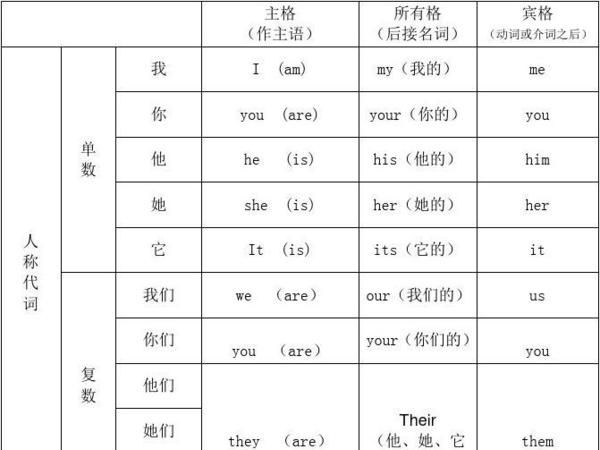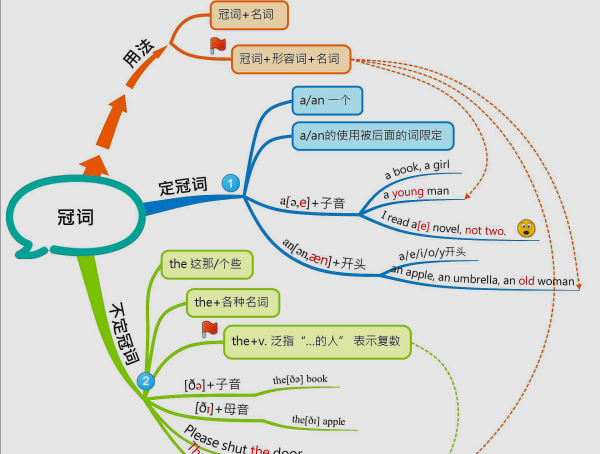本文目录
英语冠词有哪些
一、定冠词the_
1. 定冠词the和一个形容词连用,代表一类人.若其作主语,则其后的谓语动词用复数形式.
2. 由普通名词和另外一些词构成的专有名词前多数要加定冠词
3) 某些节假日前: the Spring Festival春节, the Mid-Autumn Day中秋节
但也有一些这类专有名词前不加定冠词
3. 一些乐器名称前面通常用the, 如play the guitar, play the piano.但在一些特殊的表达中不用the,如with Kenney Rogers on saxophone, with Miles Davis on trumpet.体育比赛的项目前也不加定冠词,如play chess, play volleyball / basketball.
4. 一年四季spring, summer, autumn /fall, winter 前,可用亦可不用定冠词,意思基本一样,但在美语中,通常为in the fall
5. 物质名词前一般不加定冠词,但当一些物质名词不用于一般意义,而表示该物质的特定部分,特别是当其有限制性定语时,常加定冠词
二、不定冠词a(an)
1. what 后的感叹句中,若感叹的名词是可数名词单数,不定冠词a/an不能省略.如:
What a horrible day!
2. a/an 用于指非独一无二的工作或职业
3. 疾病名称通常被认为是不可数的,因此,其前通常不加冠词
. 习惯用定冠词的表达
by the way, on the whole, in the end, on the way to, tell the truth, on the right / left, in the possession of, be in the habit of doing sth., on the spot, the day before yesterday, in the distance, in the case of, for the time being, at the hands of, in the front of, be in the dark, at the back of, to the extent of等.
2. 习惯用不定冠词的表达
as a matter of fact, as a rule, be in a position to, a matter of course, all of a sudden, be at a loss, have a chance, have a good time, have a hand in, have a say, have a try, keep an eye on, on a large scale, with a firm hand, take a fancy to, be in a hurry, take a walk, take an interest in等.
3. 习惯用零冠词的表达
at noon/night/dawn/midnight, in town, in front of, at bottom, in order, in peace, at hand, at home, at last, at present, at stake, at war, by way of, day and night, without result, on top of, in trouble, in sight, from beginning to end, in advance, in haste, in danger, in case(of), in possession of, in fashion, in fact, take part in, take place等.

英语中冠词有哪些
冠词有两种:不定冠词(a/an)和定冠词(the)。此外有些特定场合不用冠词,即通常所谓的“零冠词”。
冠词的分类
冠词分为不定冠词、定冠词、否定冠词、部分冠词和零冠词,零冠词指的是不用冠词的情况。
定冠词(例如英语中的the)用来限定这个冠词后面的名词是某个特定的事物;
不定冠词(例如英语中的a/an)用来表示这个冠词后面的名词是指某一类特定事物中的一个,但具体是哪一个并不重要;
部分冠词(例如法语中的du/de la)用来表示这个冠词后面的名词的量是不确定的;
否定冠词(例如德语中的kein)用来表示这个冠词后面的名词是不存在的。
此外,在某些语言中(比如法语),同一个名词的阳性与阴性形式,单数与复数形式的读音完全一样,通过前面不同的冠词的使用,可以让听话者区分出这个名词的不同形式。
不论这个限定性词放在被限定词或词组的前面还是后面,该限定性词总是像一顶帽子一样戴在被限定词的头上,因此这种词,诸如the,a,被称作冠词。
不定冠词表示泛指、类指,定冠词表示特指、专指、类指,零冠词表示泛指人或事物、类指。a、an,仅用在单数可数名词前来表示一的意义,但不强调数目概念,只表示名词为不特定者。定冠词the,表示名词的特定者,表示这、那、这些、那些。用在可数名词单数、复数,不可数名词前均可。则表示名词化的其他词或专有名词,因此单数复数均可。复数可数名词和不可数名词前不用冠词,也表泛指,有些语法专家称之为 零冠词 。

扩展资料:
冠词口诀
冠词分为定冠、不定冠,零冠
不定冠词a和an,—的含义表泛指,
表示特指要用the,次序、方位、最高级,
世上物体独一个,人或事物再次提,
以下情况冠词免,学科球类三顿饭,
名词复数表泛指,季节星期月份前,
冠词免不是没冠词,停顿一下(/) 再读下面。
特殊用法
1、两个形容词都有冠词,表示两个不同东西。
He raises a black and a white cat. 他养了一只黑猫和一只白猫。
The black and the white cats are hers. 这只黑猫和白猫都是她的。
A cup of tea with milk,a cup of lemon tea.一杯奶茶,一杯柠檬茶。
2、 如后一个形容词无冠词,则指一物。
He raises a black and white cat. 他养了一只花猫(黑白相间的猫)。
The black and white cat is hers. 这只花猫是她的。
冠词位置
1、不定冠词位置
不定冠词常位于名词或名词修饰语前。注意:
a. 位于下列形容词之后:such,what,many,half,
I have never seen such an animal.
Many a man is fit for the job.
b. 当名词前的形容词被副词as,so,too,how,however,enough修饰时,不定冠词应放在形容词之后:
It is as pleasant a day as I have ever spent.
So short a time.
Too long a distance.
c. quite,rather与单数名词连用,冠词放在其后。
但当rather,quite 前仍有形容词,不定冠词放其前后均可。如:quite a lot
d. 在as,though 引导的让步状语从句中,当表语为形容词修饰的名词时,不定冠词放形容词后:
Brave a man though he is,he trembles at the sight of snakes. 他尽管勇敢,可见到蛇还是发抖。
当名词被比较级形容词修饰时,不定冠词通常置于比较级形容词之后
2、定冠词位置
定冠词通常位于名词或名词修饰语前,但放在all, both,double,half,twice,three times等词之后,名词之前。
All the students in the class went out. 班里的所有学生都出去了。
Both the boys have been to London. 两个男孩都去过伦敦。
参考资料来源:百度百科词条-冠词
常见的前面加an的名词
an apple(一只苹果)、an eye(一只眼睛)、an ink-bottle(一只墨水瓶)an oil pipe-line(一条输油管);
an uncle(一位大叔)、an english book(一本英语书)、an hour(一小时)、an umbrella(一把伞);
an ear(一只耳朵)、an ox(一头公牛)、an english song(一首英语歌曲)、an arm(一条手臂)、an island(一座岛屿)、an old worker(一位老工人)。

英语冠词的用法总结:
1、不定冠词的用法不定冠词包括a/an,意思相当于one,很多情况下可以译成“一”、“每”,但是不像one一样强调数量,有时可以不译出。
2、定冠词的用法定冠词the主要对后面的名词起限定作用,“特指”是它的主要功能。
3、不用冠词(零冠词)的情况,物质名词表示泛指时不用冠词。抽象名词表示一种概念时不用冠词。表示国名、地名、人名、城市、街道、和首字母为Mount的山及大多数湖泊的专有名词前不用冠词。四季、月份、节假日、日期和星期等名词前不用冠词。
英语里的冠词指什么
英语中的冠词有三种,一种是定冠词(the Definite Article),另一种是不定冠词(the Indefinite Article),还有一种是零冠词(Zero Article)。
不定冠词a (an)与数词one 同源,是"一个"的意思。a用于辅音音素前,一般读作[e],而an则用于元音音素前,一般读做[en]。
1) 表示"一个",意为one;指某人或某物,意为a certain。
A Mr. Ling is waiting for you.
2) 代表一类人或物
A knife is a tool for cutting with.
Mr. Smith is an engineer.
定冠词the与指示代词this,that同源,有"那(这)个"的意思,但较弱,可以和一个名词连用,来表示某个或某些特定的人或东西。
定冠词的用法:
1)特指双方都明白的人或物:
Take the medicine. 把药吃了。
2)上文提到过的人或事:
He bought a house. I've been to the house.
他买了幢房子。我去过那幢房子。
3)指世上独一物二的事物:
the sun, the sky, the moon, the earth
4)单数名词连用表示一类事物,如:the dollar 美元;
the fox 狐狸;或与形容词或分词连用,表示一类人:the rich 富人; the living 生者。
5)用在序数词和形容词最高级,及形容词only, very, same等前面:
Where do you live? I live on the second floor. 你住在哪?我住在二层。
That's the very thing I've been looking for. 那正是我要找的东西。
6)与复数名词连用,指整个群体:
They are the teachers of this school.指全体教师)
They are teachers of this school. (指部分教师)
7)表示所有,相当于物主代词,用在表示身体部位的名词前:
She caught me by the arm.. 她抓住了我的手臂。
8)用在某些由普通名词构成的国家名称、机关团体、阶级、等专有名词前:
the People's Republic of China 中华人民共和国
the United States 美国
9)用在表示乐器的名词之前: She plays the piano. 她会弹钢琴。
10) 用在姓氏的复数名词之前,表示一家人:
the Greens 格林一家人 (或格林夫妇)
11) 用在惯用语中:
in the day, in the morning (afternoon,evening), the day after tomorrow
the day before yesterday, the next morning,
in the sky (water,field,country)
in the dark, in the rain, in the distance,
in the middle (of), in the end,
on the whole, by the way, go to the theatre

以上就是关于英语冠词大全常见,英语冠词有哪些的全部内容,以及冠词大全 的相关内容,希望能够帮到您。
